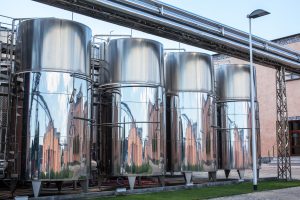
A pressure vessel is one of the most critical components in petrochemical and industrial process plants. In general, the term pressure vessel covers a wide variety of vessels ranging from separation vessels, columns, storage vessels, reactors, unit heat exchangers and many more. Because of the risks associated with pressure vessel failures and accidents, the production and operation of pressure vessels are governed by national legislation and/or standards.
Pressure vessel design standards define how different pressure vessels should be designed, tested and inspected during production and operation. These standards also define when a vessel should be considered a pressure vessel. A minimum pressure rating (usually 5.104 N/m2) is used to differentiate pressure vessels from low-pressure tanks. Pressure vessels are designed to meet requirements specified by a team of mechanical engineers, thermodynamics engineers, and process engineers.
Factors To Consider When Designing A Pressure Vessel
There are many factors that should be taken into consideration when designing pressure vessels for different applications. These factors can be divided into 3 main categories; operational, design and material considerations. Following are some of the operational considerations:
Operating Pressure
Both the normal operating pressure and the maximum maintained pressure need to be considered when designing a pressure vessel. Pressure vessel design standards define how the operating and maximum pressures are factored into the vessel design.
Fluid Conditions
Minimum and maximum fluid temperatures must be considered and factored into the overall pressure vessel design. Fluid chemical and physical properties will influence the choice of construction material. On the other hand, the specific gravity will influence support design.
External Loads
Loads to be considered include snow, wind, and local loads like connecting piping, screwed or welded connectors, and the weight of equipment supported by the vessel.
Transient Conditions
Some pressure vessels may require an evaluation of cyclic loads arising from acoustic, structural, temperature and pressure vibration loading.
Design Considerations
Next, the design considerations which encompass geometrical parameters must be defined. Most of these parameters are defined by the plant design team, while some are left to the discretion of the pressure vessel designer. Some key functional considerations to make when designing a pressure vessel include:
- Shape and size of the vessel
- Method of vessel support
- Size and location of attachments such as nozzle flanges and connectors
Material Considerations
After considering both operational and design factors, you can proceed with choosing a suitable material for construction based on the conclusions you have made. Some pressure vessel standards specific acceptable materials with appropriate design stresses and temperature ranges. When picking a material, it is important to make the following considerations:
- Creep strength at design temperature
- Ultimate tensile strength at room temperature
- Yield strength at design temperature
You can pick a suitable material based on the above material properties together with the insight of the following properties that affect production and operation of pressure vessels:
- Reduction and Elongation of material at fracture
- Notch toughness
- Embrittlement and aging under normal operating conditions
- Fatigue strength
- Availability
The scope of materials used for pressure vessels is vast and includes:
- Carbon steel (with less than 0.25% carbon)
- Carbon manganese steel (stronger than carbon steel)
- Low alloy steels
- High alloy steels
- Austenite stainless steels
- Non-ferrous materials (nickel, copper, and aluminium alloys)
- Heavy-duty bolting materials
Clad materials can also be used, but typically only the base material thickness should be used in design calculations. Also, proprietary materials can be used for unique applications by agreement between the buyer and designer, although regulatory authorities may require evidence of previous successful execution before approving the use of a specific material.
At Sherwood Design & Engineering Pty Ltd, we have been providing engineering design and support services to industries such as steelmaking, minerals processing, water treatment, food/pharmaceuticals, materials handling, and many others for more than 40 years.
We specialise in pressure vessel design and pressure vessel design verification, as well as plant engineering where design, plant layout and preparation of arrangement, fabrication and manufacturing drawings are required.
If you are looking for trustworthy and reliable pressure vessel engineering design and support services, please call us today on (02) 9437 3566 or leave an enquiry.
